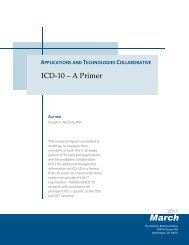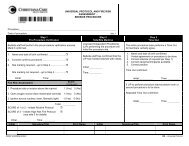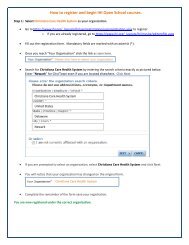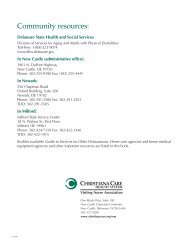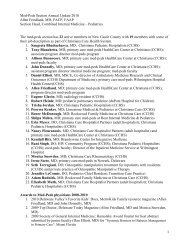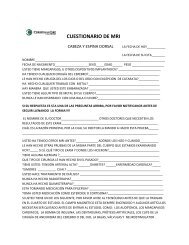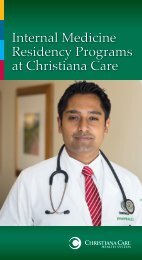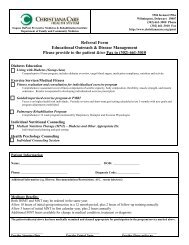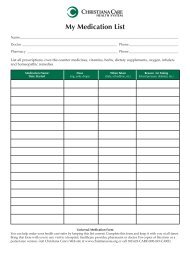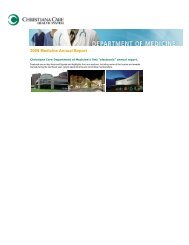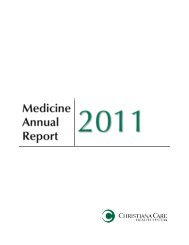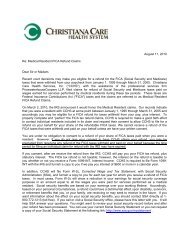Presented by Annie Ingram, MSN, NP-C - Christiana Care Health ...
Presented by Annie Ingram, MSN, NP-C - Christiana Care Health ...
Presented by Annie Ingram, MSN, NP-C - Christiana Care Health ...
- No tags were found...
Create successful ePaper yourself
Turn your PDF publications into a flip-book with our unique Google optimized e-Paper software.
<strong>Presented</strong> <strong>by</strong><strong>Annie</strong> <strong>Ingram</strong>, <strong>MSN</strong>, <strong>NP</strong>-C
Hypertension is the chronic elevation inblood pressure that, long term, causes endorgandamage, and increases morbidity andmortality. It occurs due to the abnormalfunctioning of the arterial pressure relatedto the central nervous system, reninangiotensin-aldosteronesystem, endothelialdysfunction, genetics, and environmentalfactors.
Hypertension in the most commonprimary diagnosis in America,estimating 35 million office visits peryearThe National <strong>Health</strong> and NutritionExamination Survey estimates that 50million or more Americans havehypertension
Hypertension affects half of people age60-69, and ¾ of people aged 70 andgreaterWorldwide hypertension is estimated tobe 1 billion people, with approximately7.1 million deaths per year related tohypertension
The Framingham heart study found thatthose with normal BP at age 55 have a90% risk of developing hypertension intheir lifetimeThe World <strong>Health</strong> Organization reportsthat hypertension causes 62% ofcerebrovascular disease and 49% ofischemic heart disease
The higher the BP, the greater the riskof stroke, heart attack, heart failure,and kidney diseaseEstimations state that for people withstage 1 hypertension, sustaining a12mmHg reduction in SBP over 10 yearswill prevent 1 death in 11 people
Antihypertensive therapy is associatedwith reductions in MI of approximately20-25%, stroke 35-40%, and heartfailure approximately 50%Recent data suggests that the majorityof people with hypertension withrequire two or more antihypertensivemedications to achieve goal
The pathophysiology of hypertensioninvolves cardiac output, peripheralvascular resistance, the reninangiotensin-aldosteronesystem, andthe autonomic nervous system
To maintain a normal blood pressure, a balanceof cardiac output and peripheral vascularresistance must be maintained. Most patientswith primary hypertension have a normal cardiacoutput, but a raised peripheral resistance.Peripheral vascular resistance is determined <strong>by</strong>small arterioles, the walls of which containsmooth muscle cells. Contraction of these cells isthought to be related to a rise in intracellularcalcium concentration. This may explain thevasodilatory effects of medications that blockthe calcium channels. Prolonged smooth muscleconstriction causes thickening of the arteriolarvessel, leading to a rise in peripheral vascularresistance.
The renin-angiotensin system is probably themost important endocrine system thataffects blood pressure control. Renin issecreted from the juxtaglomerular apparatusof the kidney in response to glomerularunderperfusion or a reduced salt intake. It isalso released in response to stimulation fromthe sympathetic nervous system.
Renin is responsible for converting reninsubstrate (angiotensinogen) to angiotensin I,a physiologically inactive substance which israpidly converted to angiotensin II <strong>by</strong>angiotensin converting enzyme. Angiotensin IIis a potent vasoconstrictor, thus a rise inblood pressure is seen. In addition itstimulates the release of aldosterone fromthe adrenal gland, which results in a furtherrise in blood pressure related to sodium andwater retention.
Sympathetic nervous systemstimulation can cause both arteriolarconstriction and arteriolar dilatation.Thus the autonomic nervous system hasan important role in maintaining anormal blood pressure. It is alsoimportant in the mediation of shorttermchanges in blood pressure inresponse to stress and physicalexercise.
Most likely, hypertension is relatedto an interaction between theautonomic nervous system and therenin-angiotensin system, togetherwith other factors such as sodium,circulating volume, and genetics.
Normal - < 120/80 mm HgPre-hypertension - 120-139/80-89 mm HgHypertension Stage I - 140-159/90-99 mm HgHypertension Stage II - >or= 160/100 mm Hg
The diagnosis of hypertension should bemade from at least 2 blood pressurereadings one to two weeks apartPatients should not smoke or consumecaffeine for at least two hours beforeblood pressure measurement. The bloodpressure should be measured in botharms, and the higher reading should beused
Ambulatory blood pressure monitoringis an important tool if “white coat”hypertension is suspected, whichoccurs in about 15% of the population.Normal ambulatory blood pressure forawake periods is
I have diagnosed hypertension…now what do I do???
past known blood pressure readingsfamily historypast or current symptoms or diagnosisof heart disease, CKD, asthma, COPD,diabetes, dislipidemia, or sleep apneasmoking historyphysical activity or inactivityexcessive alcohol, fat, or sodium intakeall medications currently prescribed orover-the-counter
Risk factors for hypertension include:family historyrace (most common in blacks)stressobesitya high diet in saturated fats or sodiumtobacco usesedentary lifestyleaging
Secondary hypertension may result from:renal vascular diseaseprimary hyperaldestoronismCushing’s syndromethyroid, pituitary, or parathyroiddysfunctioncoarctation of the aortapregnancyneurologic disordersuse of hormonal contraceptives, cocaine,or some medications
ClozapineCorticosteroidsHaemopoietic agents (darbepoetin, epoetin)Immunomodifiers (cyclosporin, tacrolimus)LeflunomideMonoamine oxidase inhibitors: reversibleNon-steroidal anti-inflammatory drugsOral contraceptivesOral decongestants (e.g. pseudoephedrine)SibutramineStimulants (dexamphetamine sulfate, methylphenidate hydrochloride)Venlafaxine (dose-related)Rebound hypertension may occur following abrupt withdrawal ofthe following:• bromocriptine• clonidine
American mistletoeAngel’s trumpetButcher’s broomCaffeine-containing products• (e.g. guarana, black tea, cola• nut, green tea, mate)Ephedra (ma huang)GentianGinger preparationsGinseng preparationsLicoriceMelatoninPeyotePhenylalanineSageSt John’s wort
Appropriate BP measurement An optic fundi exam A BMI calculation Pulse rate, rhythm, and character Jugular venous pulse and pressure Ascultation for carotid, abdominal, andfemoral bruits Palpation of the thyroid gland Evidence of cardiac enlargement (displacedapex, extra heart sounds)
Crackles or wheezing in the lungs Exam of the abdomen for enlarged kidneys,masses, or pulsations Palpation of lower extremity pulses Assessment for pedal edema A neurologic assessment
ECGUrinalysisBlood glucoseGFRSerum potassium, hemaglobin, andcalciumLipid panelUrine albumin and creatinine
The goal of antihypertensivetreatment is to reduce cardiovascularand renal morbidity and mortality.Therefore the goal BP should be
Weight reduction in thoseoverweightAdopting a DASH dietLowering dietary sodium intakeIncreasing physical activitySmoking cessationModerating alcohol consumption
The DASH (Dietary Approaches to StopHypertension) involves reducing dietarysodium and eating a variety of foods rich innutrients that help lower blood pressure,such as potassium, calcium and magnesium. It centers around eating whole grains, fruits,vegetables, and low-fat dairy items. A 1600mg sodium DASH diet has been shownto be similar in its antihypertensive effectsto single drug therapy.
Regular physical activity has astrong cardioprotective effect.Regular aerobic exercise can lowerSBP <strong>by</strong> an average of 4mmHg andDBP <strong>by</strong> 2.5mmHg.The recommended amount ofactivity is at least 30 minutes ofmoderate-intensity physical activity3-5 days per week.
For persons who are overweight,every 1% reduction in body weightlowers systolic BP <strong>by</strong> an average of1mmHg. Weight loss of 10kg canreduce SBP <strong>by</strong> 6-10mmHg.
Moderate to heavy alcohol intake canincrease blood pressure, therefore inthese patients, limiting alcoholconsumption can substantially lowerblood pressure.Alcohol intake should be limited to amaximun of 2 drinks per day for men,and 1 drink per day for women, with atleast 2 alcohol free days per week.
Initial drug choice should be basedon the patient’s age, presence ofassociated comorbid conditions orend-organ damage, interactions withother medications, cost, andcompliance.
Most clinical trials have found Thiazide-typediuretics to be the basis of antihypertensivetherapyIn trials such a the Antihypertensive and LipidLowering Treatment to Prevent Heart AttackTrial, diuretics were shown to be number onein preventing the cardiovascularcomplications of hypertension
Diuretics are also more affordable thanmany other antihypertensive agentsThiazide-type diuretics should be used asinitial therapy for most newly diagnosedhypertensive patientsOther first-line treatment options are anACE Inhibitor, ARB, or dihydropyridineCalcium Channel Blocker
Thiazide diuretics inhibit the sodiumand chloride transporter in the distalconvoluted tubule of the kidney,thus increasing the excretion ofsodium and water, as well asincreasing potassium loss. Thisdiuresis decreases blood volume andblood pressure.
Side effects include:HyperglycemiaHypokalemiaIncreased uric acid levelHypercalcemiaImpotencePhotosensitivityThey should be used cautiously inpatients at risk for developingdiabetes.
ACE inhibitors block the conversionof angiotensin I to angiotensin II,thus lowering peripheral arteriolarresistance and lowering bloodpressure.
Side effects include: Hypotension Cough Hyperkalemia Headache Dizziness Fatigue Nausea Renal impairment ACE inhibitors are contraindicated in pregnancyand bilateral renal artery stenosis.
ARBs are receptor antagonists thatblock angiotensin II receptors on bloodvessels and other tissues such as theheart. These receptors stimulatevascular smooth muscle contraction.Because ARBs do not inhibit ACE, theydo not cause an increase in bradykinin,which produces some of the sideeffects of ACE inhibitors (cough andangioedema).
Side effects include: Hyperkalemia Hypotension Dizziness Headache Drowsiness Diarrhea Abnormal taste sensation (metallic or saltytaste) Rash ARBs are contraindicated in pregnancy andbilateral renal artery stenosis.
Calcium channel blockers work <strong>by</strong> blockingcalcium channels in cardiac muscle and bloodvessels. This decreases intracellular calciumleading to a reduction in muscle contraction. In the heart, a decrease in calcium availablefor each beat results in a decrease in cardiaccontractility, which in turn decreases cardiacoutput. In blood vessels, a decrease in calciumresults in less contraction of the vascularsmooth muscle, causing vasodilatation andtherefore decrease in peripheral vascularresistance.
There are two types of Calcium ChannelBlockers:Dihydropyridine, such as amlodipine,nifedipine, and felodipineNon-dihydropyridine, such as verapamiland diltiazem.
Dihydropyridine CCBs reduce peripheralvascular resistance.• Side effects include dizziness, tachycardia,bradycardia, headache, flushing, edema, andconstipation.Non-dihydropyridine CCBs reduce myocardialoxygen demand and reverse coronaryvasospasm.• Side effects include excessive bradycardia,impaired electrical conduction (e.g.,atrioventricular nodal block), and depressedcontractility.
Beta-adrenergic blocking agents, orbeta blockers, work <strong>by</strong> blocking theneurotransmitters norepinephrine andepinephrine (part of the sympatheticnervous system) from binding toreceptors in different parts of thebody. This causes smooth muscle cellsto relax.
There are three types of betareceptors:Beta1, located mainly in the heartand kidneysBeta2, located in the lungs, GI tract,liver, uterus, vascular smoothmuscle, and skeletal muscleBeta3, located in fat cells
First generation beta blockers, such aspropranolol and sotalol, are nonselective,therefore they will block thereceptors of beta1 and beta2 cells.Second generation beta blockers, suchas metoprolol, are selective and willonly block the receptors of beta1 cells.This reduces heart rate, force ofcontraction, and cardiac output.
Beta blockers also affect theproduction of renin, which in turnrelaxes smooth muscle cells and lowersblood pressure.
Side effects of beta blockers include: BradycardiaCold extremitiesFatigueInsomniaDizzinessWheezingDigestive problemsRashErectile dysfunctionThey should be used cautiously in patientswith asthma.
Thiazide-type diretics have beenshown to slow the progression ofosteoporosis.Beta Blockerss are also useful forthe treatment of atrialtachyarrhythmias, migraine,thyrotoxicosis, essential tremor, andperioperative hypertension.Calcium Channel Blockers can beuseful in Raynaud’s syndrome andcertain arrhythmias.
Thiazide diuretics should be usedcautiously in patients with a history ofgout or hyponatremia.BBs should be avoided in patients withreactive airway disease or 2nd or 3rddegree heart block.
ACEIs and ARBs should not be given towomen who are or may becomepregnant. ACEIs should not be used inpatients with a history of angioedema.Thiazide diuretics have been associatedwith increased risk of new-onsetdiabetes, and should be used withcaution in patients with glucoseintolerance.
Start with the lowest recommended doseof the selected agent.If the drug is not well tolerated, switch toa drug of a different class.If target blood pressure is not reached,increase the first agent, or add a secondagent.Addition of a second agent should beconsidered when adaquate doses of thefirst agent have not produced adaquateresults. It is better to add a second agentbefore maxing out a first, to decrease thelikelihood of potential side effects thatcan be seen with higher doses.
If a patient is taking a midrange dose andis still >5-10mmHg above goal, adding asecond agent is more litely to be effectivethan increasing the dose.If blood pressure is still above target,increase one agent at a time. Trial eachdose regimen for at leaset 6 weeks,because most drugs take at least 3-4weeks to achieve maximum benefit.Once a combination regimen is toleratedand doses are established, the patientcould be switched to a combinedpreparation.
If blood pressure remains elevateddespite optimal doses of at least twoagents after a reasonable time, considerthe following potential reasons:• Non-compliance to therapy- compliance decreasesas number of times per day dose increases (79%once daily, 69% BID, 65% TID, 51% QID)• Use of medications that may increase bloodpressure (NSAIDS, stimulants, sympathomimetics,alcohol, contraceptives, estrogen, corticosteroids,licorice, caffeine pills, cold medicines, ephedra,ginseng, St. John’s wort)
• secondary hypertension, such as CKD/obstructiveuropathy, renovascular hypertension, aorticcoarctation, cushing’s syndrome, thyroid disease• undiagnosed sleep apnea• undisclosed alcohol, tobacco, or drug use• undisclosed or unrecognized high sodium diets• “white coat” hypertension- for which 24 hourambulatory blood pressure monitoring may behelpful
Most people will require at lease twomedications to control their hypertensionGuidelines recommend a combinationtherapy as initial therapy in high-riskhypertensive individuals, when initial BPis >20/10 above goalAvoid: ACE Inhibitors plus potassiumsparingdiuretics, Beta-blockers plusVerapamil, and ACE Inhibitors plus ARBs
ACEIs and CCBs: Lotrel (amlodipinebenazepril),Lexxel (trandolaprilverapamil)ACEIs and diuretics: Lotensin HCT(Benazepril-HCTZ), Zestoretic (Lisinopril-HCTZ), Vaseretic (Enalapril-HCTZ)ARBs and diuretics: Atacand HCT(Candesartan-HCTZ), Hyzaar (Losartan-HCTZ), Benicar HCT (Olmesartan-HCTZ),Diovan HCT (Valsartan-HCTZ)
BBs and diuretics: Tenoretic (Atenololchlorthalidone),Lopressor HCT (Metoprolol-HCTZ) Diuretic and diuretic: Aldactazide(Aldactone-HCTZ), Maxzide (Triamterene-HCTZ)
Follow-up should include monthly bloodpressure checks until goal is reached.More frequent visits may be indicatedfor patients with stage II hypertension,or those with comorbid conditions.After blood pressure is shown to be atgoal, visits can generally be moved toevery 3 to 6 months
Serum creatinine and potassium shouldbe monitored 1-2 times per yearTobacco avoidance should be stronglyencouragedLow dose aspirin therapy can beconsidered when a patient is at goal,but not sooner due to risk ofhemorrhagic stroke with uncontrolledHTN
Patient motivation improves bloodpressure control and should beencouraged at each visit. Home bloodpressure monitoring can help patientstake ownership of their hypertension, andso become motivated to adhere totreatment.The cost of medications can also affectcompliance. Wal-mart has a $4 drug list,that can be helpful for those withoutinsurance.
Amiloride-HCTZ 5mg-50mg Atenolol-Chlorthalidone100mg Atenolol 25, 50, 100mg tab Benazepril 5, 10, 20, 40mg Bisoprolol-HCTZ 2.5mg-6.25mgtab Bisoprolol-HCTZ 5mg-6.25mg Bisoprolol-HCTZ 10mg-6.25mgtab Captopril 12.5, 25, 50, 100mg Carvedilol 3.125, 6.25, 12.5,25mg tab Clonidine 0.1, 0.2mg tab Diltiazem 30, 60, 90, 120mgtab Doxazosin 1, 2, 4, 8mg tab Enalapril-HCTZ 5mg-12.5mg Enalapril 2.5, 5, 10, 20mg tab Furosemide 20, 40, 80mg tab Hydralazine 10, 25mg tab Hydrochlorothiazide(HCTZ)12.5mg cap Hydrochlorothiazide (HCTZ)25, 50mg tab Indapamide 1.25, 2.5mg tab Isosorbide Mononitrate 30,60mg ER tab Lisinopril-HCTZ 10mg-12.5mg
Lisinopril-HCTZ 20mg-12.5mg Lisinopril-HCTZ 20mg-25mg Lisinopril 2.5, 5, 10, 20mgtab Methyldopa 250mg tab Metoprolol Tartrate 25,50, 100mg tab Nadolol 20, 40mg tab Prazosin HCL 1mg cap Propranolol 10, 20, 40,80mg Sotalol HCL 80mg tab Spironolactone 25mg tab Terazosin 1, 2, 5, 10mgcap Triamterene-HCTZ 75mg-50mg tab Triamterene-HCTZ37.5mg-25mg tab Verapamil 80, 120mg tab
Withdrawl of antihypertensives may beconsidered in patients who haveachieved target blood pressure at lowdoses and agree to continue lifestylemodifications, undergo regular bloodpressure monitoring, and reinstituteantihypertensives if necessary.
Ischemic heart diseaseThe most common form of target organdamage associated with hypertension isIschemic heart disease.In patients with hypertension and stableangina, beta-blockers or long actingcalcium-channel blockers are indicated.In patients with ACS, treatment should bebeta blockers and ace inhibitors, as wellas nitrates.For patients post-MI, beta blockers, ACEIs,and aldosterone antagonists have shownto be the most benificial. Aspirin and lipidtherapy should also be initiated.
Heart failureFor paitents with systolic heart failure, orleft ventricular dysfunction, ACEIs and BBsare recommended.For those who are symptomatic or at endstageheart disease, ACEIS, BBs, ARBs,aldosterone blockers, and loop diureticsare indicated.
Diabetic HypertensionUsually a combination of two or moreantihypertensives will be needed toachieve a blood pressure of
Chronic Kidney Disease In patients with CKD, the goal of therapy is toslow deterioration of renal function, and preventcardiovascular disease. Target blood pressure in these patients is
Cerebrovascular diseaseIn an acute stroke, blood pressure isrecommended to be maintained around160/100 until the condition has stabilized.A combination of thiazide-type diureticsand ACEIs have been shown to lowerrecurrent stroke rates.Aggressive antihypertensive therapyappears to be safe to reinitiate 1-2 weeksafter the acute event, when the patienthas been deemed clinically stable.
PregnancyMethyldopa, Beta Blockers, andvasodialators are considered to be thesafest medications.ACEIs and ARBs should not be used due tothe possibility of fetal defects.Methydopa and labetalol are the mostwidely used medications to treat pregnantwomen.
Hypertensive EmergencyHypertensive Urgency is defined as SBP > or=180 and/or DBP >or=120 without evidenceof target organ dysfunction. These patientsrequire immidiate intervention and may needto be hospitalized.Hypertensive Emergency is defined as SBP>or= 180 and/or DBP >or=120 with evidenceof target organ dysfunction, such as coronaryischemia, disordered cerebral function,cerebrovascular events, pulmonary edema,and renal failure. These patients requirehospitalization and immediate treatment.
ReferencesCampbell, N. Hemmelgarn, B. (2012). New recommendations for the use of ambulatoryblood pressure monitoring in the diagnosis of hypertension. Canadian MedicalAssociation Journal, 184(6), 633-634.Corrao, G., Nicotra, F., Parodi, A, Zambon, A. (2011). Cardiovascular protection <strong>by</strong>initial and subsequent combination of antihypertensive drugs in daily life practice.Hypertension, 58(4), 566-572.Mukherjee, D. (2012). Atherogenic vascular stiffness and hypertension: Cause or effect?The Journal of the American Medical Association, 308(9), 919-920.Park, C., Youn, H., Chae, S. (2012). Evaluation of the dose-relationship of Amlodipineand Losartan combination in patients with essential hypertension. American JournalCardiovascular Drugs, 12(1), 35-47.
ReferencesSever, P., Messereli, F. (2011). Hypertension management 2011: Optimal medicaltherapy. European Heart Journal, 32(20), 2499-2506.http://www.heartfoundation.org.au/SiteCollectionDocuments/HypertensionGuidelines2008to2010Update.pdf Retrieved December 11, 2012http://www.icsi.org/hypertension_4/hypertension_diagnosis_and_treatment_4.html RetrievedDecember 11, 2012http://www.nhlbi.nih.gov/guidelines/hypertension/jnc7full.pdf Retrieved December 11, 2012
1. The percentage of adults in the UnitedStates with Hypertension is:C )30%
2. Risk factors for Hypertension include allof the following except:D) Cancer
3. Which of the following is a potentialsecondary drug-induced cause ofhypertension?C) Phenylpropanolamine
4. Which of the following patients is atvery high risk for cardiovascular diseaseand should immediately receive amedication to lower blood pressure?C) A 68-year-old man with heart failureand a baseline blood pressure of 150/88mm Hg
5. Which of the following would be mostappropriate for a patient withhypertension who has had a myocardialinfarction?C) Metoprolol
6. Which of the following is the mostappropriate blood pressure goal for a 65-year-old African-American withhypertension and no other medicalproblems?A)
7. In order to minimize the risk ofhypokalemia from diuretics, the mostappropriate strategy would include:A) limiting the dose ofhydrochlorothiazide to 12.5 to 25 mg
8. In a patient with heart failure, the bestcombination of medications would be:C) Lisinopril and Coreg
9. Which of the following is anappropriate agent and starting dose for apatient with uncomplicatedhypertension?A) Atenolol 25 mg once daily
10. Which drug is most likely to causevasodilation-type side effects (headache,flushing) because it blocks themovement of calcium across smoothmuscle cells?E) Verapamil
11. When patients with renal insufficiencydevelop severe cough from ACEinhibitors, what would be the bestalternative to provide renal protection?C) Losartan
12. Which of the following is trueconcerning clonidine?A) It has been used for smokingcessation and narcotic withdrawal.
13. Which of the following is acontraindication to enalapril?A) Bilateral renal artery stenosis
14. What potential side effects would youmention to a patient recently started onnifedipine?D) Leg edema
15. A 39-year-old woman withhypertension is taking HCTZ, enalapril(Vasotec), and diltiazem (Cardizem). Shedesires to become pregnant. The mostimportant step would be toD) discontinue enalapril.
16. The agent of choice for a patient withdiabetes isE) enalapril.
17. Which one of the following nondrugmeasures is likely to be most effective tolower blood pressure chronically?C) Lose 10-15 pounds



